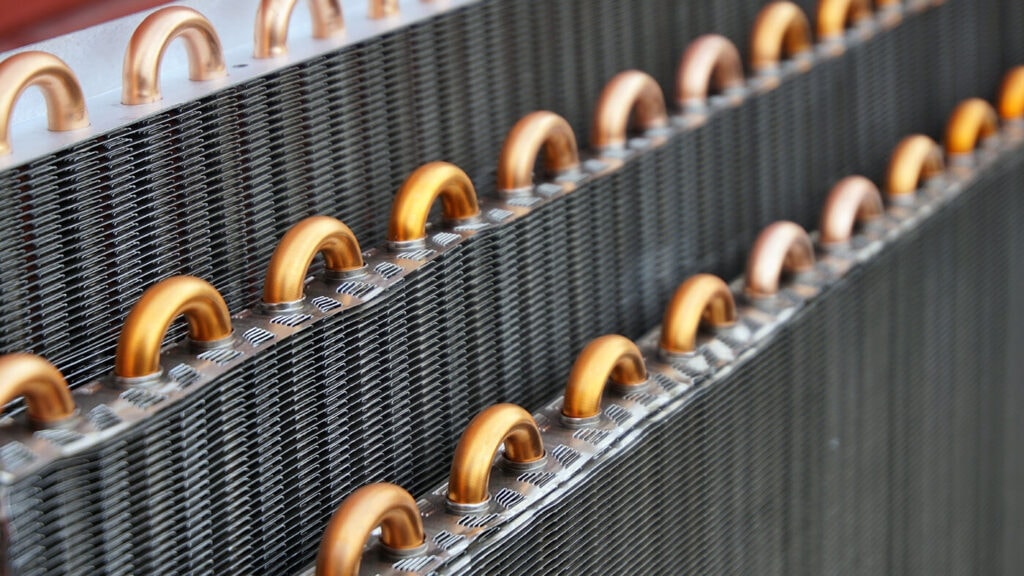The term heat exchanger refers to the metal coil, tube, or plate assembly that shuttles warmth from one air stream to another without letting the two streams mingle. Because no direct contact occurs, the indoor air you breathe stays clean while the device does its job.
Have you ever asked, “What is a heat exchanger in HVAC?” Picture two lanes on a highway separated by a solid barrier: traffic (heat) can switch lanes only at specific ramps (the exchanger’s metal walls), never colliding head-on. That barrier keeps fuel fumes on one side and cabin air on the other, much like your furnace keeps combustion gases outside your living space.
What Does a Heat Exchanger Do?
A single task drives the part’s entire existence—move thermal energy from one medium to another. So, when people wonder what heat exchangers do, the simplest answer is: they pass heat along. In winter, the exchanger transfers warmth from hot furnace gases to the indoor air blowing across it. In summer, it routes indoor warmth outdoors through refrigerant loops, making living spaces pleasantly cool.
How Do Heat Exchangers Work in Air Conditioners?
Inside every split system sits an air conditioner heat exchanger called the evaporator coil. Refrigerant enters the coil as a cold liquid, absorbs indoor warmth, and turns into a gas. A second exchanger—the outdoor condenser coil—then releases that heat to the open air; the refrigerant condenses back to liquid, ready to repeat the cycle. Fans, compressors, and expansion valves keep the loop humming, but the two exchangers are the real heroes behind the chill.
Types of Heat Exchangers Used in HVAC
Different situations call for different shapes and materials, each balancing cost, efficiency, and durability.
- Tubular or Serpentine Coils
Long tubes wind back and forth, maximizing surface area while staying compact. They appear in gas furnaces and some ductless mini-split systems. - Plate or Finned-Tube Units
Thin metal plates or finned copper tubes widen the contact zone between air and refrigerant, making them popular in air handlers and rooftop units. - Plate-and-Frame (Counter-Flow) Designs
Two air streams travel in opposite directions along stacked plates, squeezing out extra efficiency ideal for energy-recovery ventilators (ERVs). - Double-Pipe Shells
One pipe fits inside another, letting water or glycol remove or add heat. These show up in hydronic boilers and commercial chillers.
Each style brings its own balance of installation ease, maintenance needs, and price. Your HVAC professional will pick the model that matches the climate, fuel source, and building layout.
Benefits of Residential Heat Exchangers
A well-chosen residential heat exchanger does more than keep rooms cozy. Homeowners also enjoy:
- Energy savings. By reclaiming warmth from exhaust air (in ERVs) or using efficient metal alloys in coils, modern units trim utility bills without extra controls.
- Better indoor air. The sealed barrier keeps combustion by-products outside and can even pre-warm incoming fresh air, lowering wintertime drafts.
- Longer equipment life. Because the exchanger guides heat exactly where it should go, compressors and blowers don’t run as hard, reducing wear and tear.
- Quieter operation. Efficient heat transfer means fans can spin at lower speeds, cutting background noise.
- Smaller carbon footprint. Lower energy use translates to fewer greenhouse gas emissions over the system’s lifespan.
Signs Your Heat Exchanger Needs Attention
Like any component that fights daily temperature swings, an exchanger can develop problems. Watch for these warnings:
- Odd smells or fumes. A metallic or gas odor may indicate a crack in a furnace exchanger, letting exhaust leak into the supply air.
- Visible rust or corrosion. Moisture, acidic condensate, or poor venting can eat through metal walls.
- Soot or discoloration. Dark streaks around burners point to incomplete combustion and possible exchanger damage.
- Unusual sounds. A ticking or pinging noise after shut-off sometimes means metal panels are warping from stress.
- Rising utility bills. If the device can’t transfer heat properly, the system runs longer to meet thermostat settings.
- Frequent short cycling. Safety switches may trip to prevent overheating, causing the unit to start and stop more than normal.
When in doubt, schedule a professional inspection. Technicians use cameras, combustion-gas sensors, and pressure tests to verify the exchanger’s integrity and decide whether repair or replacement is the safer route.
Conclusion
Heat exchangers quietly power the comfort you rely on, whether they’re whisking furnace heat into the living room or shedding indoor warmth to the summer sky. Know how they work, choose the right style, and keep an eye out for trouble signs, and your HVAC system will reward you with lower bills and better air.
Need a trusted team to handle inspections, repairs, or upgrades? Air Duct LV has you covered.


Related Stories
Stay Cool in the Desert: Expert HVAC Repair in Las Vegas with Air Duct LV
Living in Las Vegas means one thing for sure — you can’t afford to have
Aug
Why AC Leaks Happen—and How We Fix Them Fast
Few things are more frustrating than noticing water pooling near your air conditioner or finding
Jul
Aging Ductwork in Vegas Homes: Risks & When to Replace Instead of Clean
You probably don’t think much about your air ducts—until your home starts feeling less comfortable,
Jul
Duct Sealing Explained: Why It Matters Post-Cleaning
After getting your air ducts cleaned, you might think the job’s done. But sealing them
Jul